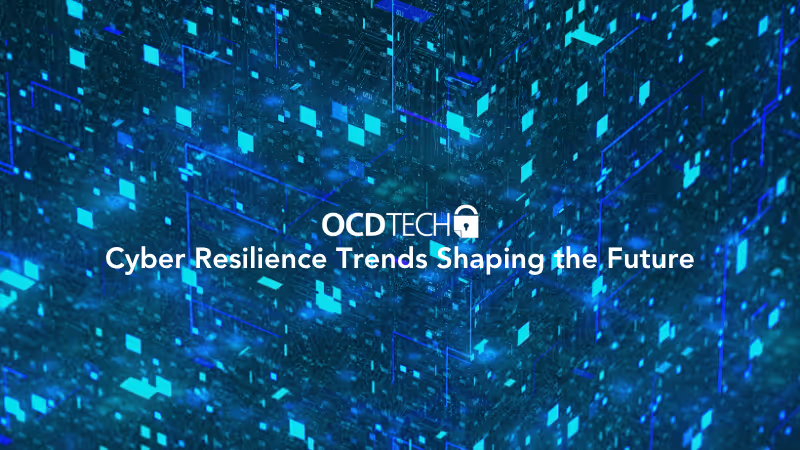By
OCD Tech
•
3
min read

A single phishing email, an unpatched system, or one distracted employee can bring business operations to a halt. That’s why cyber resilience, more than just defense, is now about anticipating disruption, adapting quickly, and bouncing back stronger.
Traditionally, cybersecurity strategies have been reactive — focused on damage control after an incident occurs. This approach often leaves organizations vulnerable to significant financial and reputational damage.
As cyber threats grow more sophisticated, businesses are shifting toward proactive resilience — anticipating potential risks and implementing strategies to mitigate them before they happen. This change demands a new mindset: prevention must be prioritized over remediation.
Integrating threat intelligence and predictive analytics into cybersecurity enables businesses to detect vulnerabilities early and anticipate attacks. By analyzing patterns in network traffic and user behavior, organizations can identify anomalies and prevent breaches before they occur.
Predictive analytics tools also allow companies to simulate potential attack scenarios, stress-test their defenses, and improve preparedness. This not only reduces the likelihood of incidents but also builds stakeholder confidence in an organization’s ability to safeguard its data.
For years, cybersecurity was viewed as a purely technical issue — the responsibility of IT departments. But with attacks growing in scale and impact, it’s now a strategic business priority.
Leaders must embed cyber resilience into the company’s culture, ensuring every department understands its role in protecting digital assets. Aligning cybersecurity goals with business objectives encourages collaboration across teams and ensures security considerations are part of every decision.
Strong leadership is essential for creating a culture of resilience. Executives who prioritize cybersecurity set the tone for the entire organization.
This includes:
When leaders model responsible behavior and emphasize accountability, cybersecurity becomes a shared responsibility rather than an isolated task.
The rise of artificial intelligence (AI) and machine learning (ML) has transformed modern cybersecurity. These technologies enable faster threat detection, real-time analysis, and automated incident response — all critical for maintaining cyber resilience.
AI-driven tools can:
Automation also plays a growing role in resilience. Automated incident response systems minimize downtime, enforce consistency, and reduce human error during crises. By handling routine tasks automatically, cybersecurity teams can focus on complex investigations and long-term strategy.
Cyber threats don’t exist in isolation — and neither should defenses. Collaboration between the public and private sectors enhances the global ability to respond to cybercrime.
Information-sharing initiatives help governments and businesses pool knowledge, resources, and expertise. Joint efforts lead to standardized protocols, shared threat intelligence databases, and unified response strategies.
Within industries, collaboration among competitors can also strengthen overall resilience. By exchanging insights and best practices, organizations can collectively reduce vulnerabilities that affect the entire sector.
Technology may be the backbone of cybersecurity, but people remain its most crucial component. Human error still accounts for a majority of breaches, making training and awareness indispensable.
Effective programs should:
Interactive workshops, simulations, and gamification can make training more engaging and memorable. Recognizing and rewarding good security behavior reinforces a sense of shared responsibility and vigilance.
Creating a security-conscious culture means building an environment where employees feel comfortable discussing potential threats without fear of blame — ensuring early detection and response.
Cyber resilience is not a one-time effort; it’s a continuous process. Organizations must regularly review and update their security measures to adapt to the changing threat landscape.
Key actions include:
Emerging technologies such as blockchain, quantum computing, and the Internet of Things (IoT) bring both opportunities and new risks. Businesses must invest in research and adapt their defenses accordingly to remain resilient as the digital ecosystem evolves.
The future of cyber resilience lies in a proactive, integrated, and collaborative approach. By making cybersecurity a business priority, embracing technologies like AI and automation, and fostering a culture of awareness, organizations can stay ahead of threats.
Cyber resilience isn’t just about preventing attacks — it’s about ensuring your business can adapt, recover, and emerge stronger from any disruption. The companies that commit to vigilance, adaptability, and leadership in cybersecurity today will be the ones that thrive in the digital world of tomorrow.

Audit. Security. Assurance.
IT Audit | Cybersecurity | IT Assurance | IT Security Consultants – OCD Tech is a technology consulting firm serving the IT security and consulting needs of businesses in Boston (MA), Braintree (MA) and across New England. We primarily serve Fortune 500 companies including auto dealers, financial institutions, higher education, government contractors, and not-for-profit organizations with SOC 2 reporting, CMMC readiness, IT Security Audits, Penetration Testing and Vulnerability Assessments. We also provide dark web monitoring, DFARS compliance, and IT general controls review.
Contact Info
.svg)
OCD Tech
.svg)
25 BHOP, Suite 407, Braintree MA, 02184
.svg)
844-623-8324
.svg)
https://ocd-tech.com
Follow Us
Videos
Check Out the Latest Videos From OCD Tech!
Services
SOC Reporting Services
– SOC 2 ® Readiness Assessment
– SOC 2 ®
– SOC 3 ®
– SOC for Cybersecurity ®
IT Advisory Services
– IT Vulnerability Assessment
– Penetration Testing
– Privileged Access Management
– Social Engineering
– WISP
– General IT Controls Review
IT Government Compliance Services
– CMMC
– DFARS Compliance
– FTC Safeguards vCISO